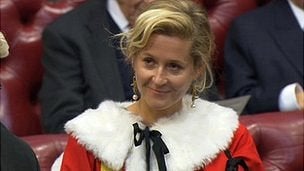Errors & Omissions: When is a baroness not a baroness? Titles still cause confusion
Our pedant-in-chief casts his eye over the past week’s Independent

We ought to get titles right. On a business page last Saturday, we published a disastrous picture caption. It carried the headline “Back off the net, Baroness tells Obama”. The text began: “Dame Martha Lane Fox, the Government’s former internet adviser, yesterday rejected Barack Obama’s recent claim that America ‘owns’ the internet.”
First, although life peeresses carry the style Baroness, they are not referred to as baronesses, but peeresses. But in any case, why not identify the peeress in question in the headline? She is well enough known. Second, Martha Lane Fox is not and never was a dame. Before she was elevated to the peerage, the highest honour she had received was CBE.
So, let the headline read “Back off the net, Lane-Fox tells Obama”, and let the text begin: “Baroness Lane-Fox, the Government’s former internet adviser …” What’s wrong with that?
(In case you are wondering, her name and title, as quoted above, are both correct. There is a hyphen in the title, but not the name. I’m not sure why.)
And finally, American titles, such as they are, deserve a measure of respect too. Mr Obama should be “President Barack Obama” at first mention.
• “Too many deaths in custody are preventable, says human rights body.” That headline, on Monday, was just a little bit wrong. It seems to suggest that it would have been all right if the deaths had been inevitable. What the writer meant to say was that preventable deaths are allowed to happen, which is not quite the same thing.
And, as always, the use of “too many” in this kind of context prompts a question. How many would have been all right?
• A generous helping of metaphor soup from Ukraine on Wednesday: “Urgent attempts to stop the fragile ceasefire in Ukraine from shattering continued yesterday amid continuing uncertainty over a key plank of the peace deal.”
For some reason, reporters love key planks. But what is a key plank? It sounds like a term from medieval carpentry, the equivalent of a keystone, but in a hammer-beam roof. A jolly idea, but I don’t believe it, especially when you consider what these planks are.
They are the components of a platform. The term is, I think, from American politics. A platform is, literally, what a candidate stands on to make a speech. Metaphorically it is the programme upon which he or she stands before the voting public, and the planks are the policies intended to attract votes.
Is a peace deal made of such planks, in that sense? No, it isn’t, and we are still left wondering how a key plank can be both a key and a plank.
• A picture caption published on Thursday began thus: “Douglas Flint, chairman of HSBC, after being quizzed by the Treasury Select Committee …” “Quizzed” for questioned is journalese. Like “cash” for money and “slam” for criticise, it should never appear in a newspaper that hopes to please discriminating readers.
Join our commenting forum
Join thought-provoking conversations, follow other Independent readers and see their replies
Comments
Bookmark popover
Removed from bookmarks